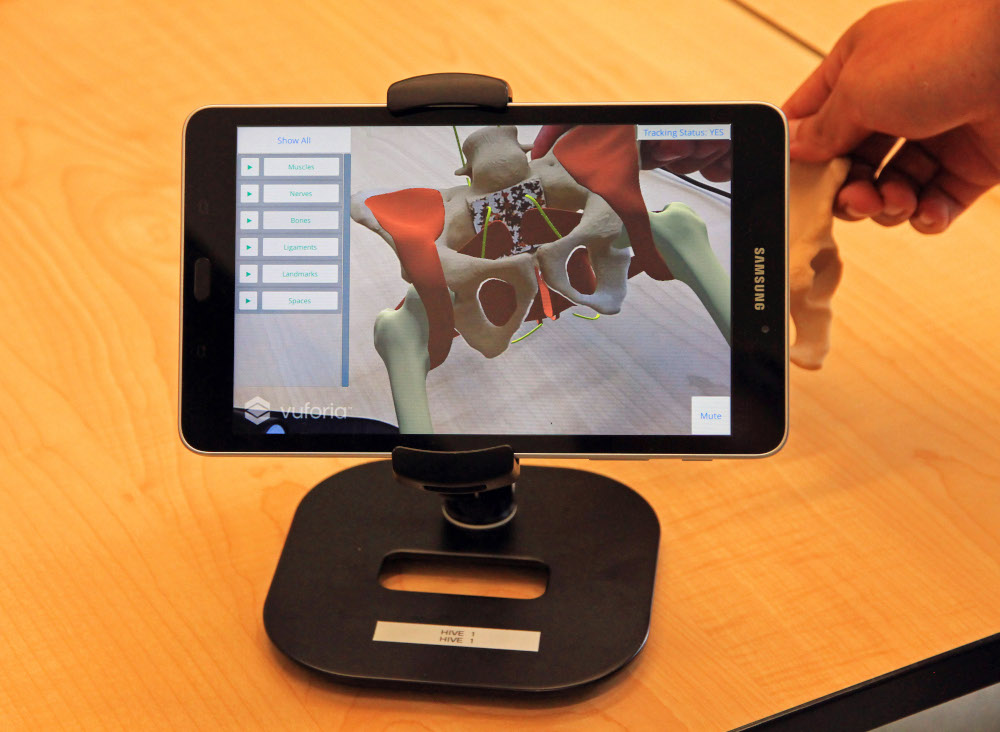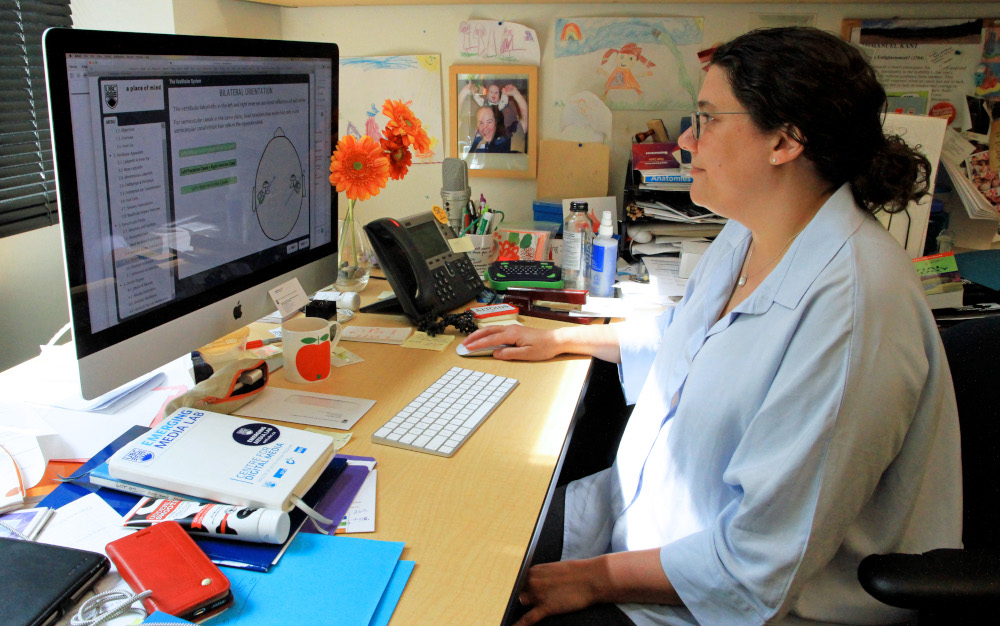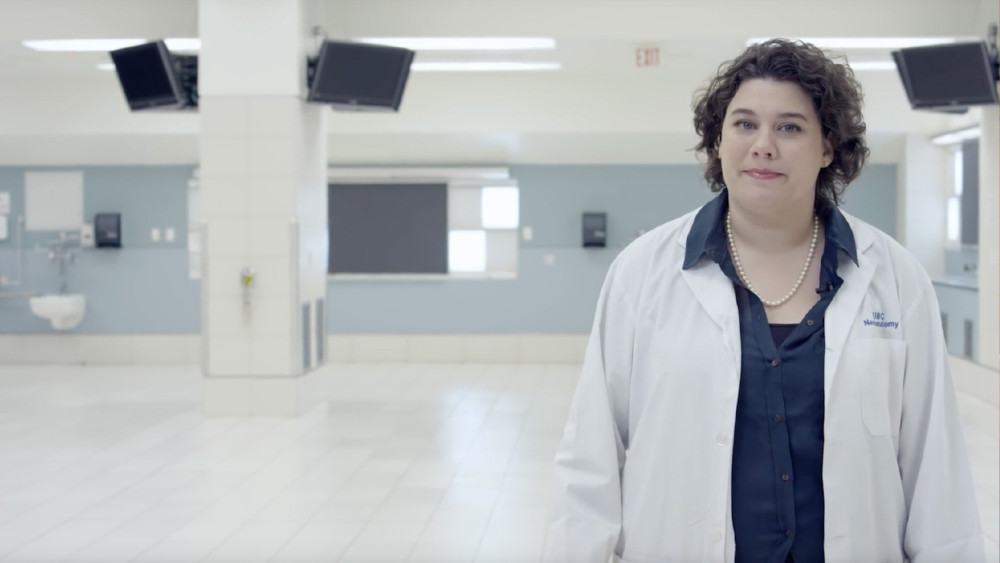“The human brain has 100 billion neurons, each neuron connected to 10,000 other neurons. Sitting on your shoulders is the most complicated object in the known universe.” — Michio Kaku, American physicist
“What we’re really doing here is trying to tell the story of what it is to be human.” — Claudia Krebs
Claudia Krebs is standing beside a blackboard at the Life Sciences Institute on the UBC campus discussing the challenges involved in teaching a course that often puts an unholy fear into many of her students: “It’s not uncommon for me to have students leave my classroom in tears. As an educator, that’s definitely not something you want to see.”
Krebs, a senior instructor in the Department of Cellular and Physiological Sciences at UBC’s Faculty of Medicine, teaches a course entitled Brain and Behaviour. The complexity of the subject matter is known to induce a documented psychological condition known as neurophobia, which refers to the anxiety that washes over medical students when they are first introduced to the convoluted inner wiring of the brain and the sheer volume of information they are asked to absorb.
To combat this syndrome, Krebs has spent several years radically revamping her course’s traditional lecture and textbook structure in an effort to make the biology of the brain more accessible and less threatening to students. She has altered the course’s pace and content and begun employing new teaching methods that dive headlong into the futuristic dimension where physical and virtual objects coexist and interact in real time.
These efforts have earned Krebs international acclaim, fan mail from around the globe, fostered connections with leading academics and helped win her several teaching prizes, including the 2018 UBC Killam Teaching Prize in the Faculty of Medicine, awarded annually to faculty members in recognition of excellence in teaching.
Her path down this career-defining corridor began in 2014 when she applied for and received a $60,000 grant from UBC’s Flexible Learning Initiative, which aims to give students more choice in when, where and how they learn. The grant financed the production of the first installment of a series of videos, created in conjunction with a UBC MedIT Educational Technology team led by video and digital media producer Zac Rothman.
The team, which included undergrads as co-producers, eventually created 18 high-quality and stylistically adventurous 10-minute videos about such topics as the central nervous system, the spinal cord, visual pathways and the cerebellum.
Krebs served as narrator and writer for these mini documentaries, which blend the presentation of hard facts and actual dissection work with artistic flourishes such as violin solos, choreographed dance routines and Monty Pythonesque graphics. The goal was to find visual hooks that would embed the scientific concepts in the viewer’s mind.
The videos were posted on YouTube with accompanying modules so students could study them at their convenience, and then come to teaching sessions more confident in the basic science and ready for clinical experiences. In other words, the basic learning of the fundamentals was done at home, while the reinforcing “homework” was done in class.
But to Krebs’s surprise, the impact of the videos extended far beyond her classroom. Without any marketing or branding efforts, they became a viral sensation in academic circles. Today, they are used in the curriculums of several universities in North America and Europe and drive a steady flow of traffic to the website that Krebs curates, www.neuroanatomy.ca, which receives a million hits per year and which, in keeping with the offbeat, sci-fi mood of her videos, opens with a tingly jazz soundtrack and shots of Krebs slicing open a human brain.
The innovation didn’t end with the videos. Krebs has gone on to integrate several cutting-edge forms of technology into her teaching, including augmented and virtual reality.
One of these digital wonders, the HoloBrain, blends virtual 3D content with real 2D images obtained from MRI scans. The app was developed in 2017 as part of a joint effort conducted by Krebs, members of UBC’s Emerging Media Lab and a select group of Canadian university students enrolled in Microsoft Vancouver’s Garage Internship Program, and uses a modified HoloLens, the world’s first fully self-contained holographic computer.
Krebs leads me into an adjoining room to demonstrate how it works. One of her students affixes a black, cyborg-like visor to my head and a hologram of the human brain suddenly appears in front of me. It floats eerily in mid-air, its hemispheres, interior vessels and fibres lit in bright, glowing colours. “Give it a command,” someone calls out. “Rotate,” I say, and the brain begins to spin in place. “Split,” I say, and the apparition obligingly divides into two sections.
Krebs explains why the HoloBrain is such an effective teaching tool. “It took 10 years of study for me to accumulate the knowledge that allows me to understand the three-dimensionality of the brain. Students are only here for a few weeks. They don’t have 10 years. The HoloBrain allows them to get inside my head and view the brain’s interior architecture through my eyes.”
After sampling the HoloBrain, I’m shown some other projects that are either completed or underway in this four-room complex. The facility, which Krebs created in 2017 through the UBC Faculty of Medicine’s Strategic Investment Fund, is known as the HIVE, short for Hackspace for Innovation and Visualization in Education. It functions as a laboratory for innovation in biomedical education and brings together students from various disciplines.
The name was chosen because it seemed a natural fit with Krebs’s pastime of keeping bees. She maintains two hives in her backyard. “It’s a fabulous hobby that requires complete immersion and focus,” she says. It also requires amenable neighbours. Krebs jokes that she keeps hers on her side with “hush honey.”
Even though it’s summer, the HIVE is abuzz with activity with a dozen students working on various individual projects. I’m shown the Pocket Pelvis, an augmented reality app that provides a colour-coded visualization of the pelvic area, one of the most anatomically complex sections in the body. When an unadorned plastic model of the pelvis is held behind a small computer screen it suddenly becomes three-dimensional, as ligaments, cartilage and interior organs materialize like the props in some magic trick.

Lying nearby is a mannequin, part of an ongoing project to create a more affordable alternative to the state-of-the-art medical mannequins now being used by some schools to evaluate new medical procedures and train aspiring doctors. These marvels of engineering can bleed, blink, suffer heart attacks and even give birth. But they come at a price, retailing for about $100,000 a piece. Students at the HIVE are trying to use augmented reality techniques to transform basic $500 CPR dummies into patient simulators capable of doing some of the same things as the high-tech models.
In another room I don another even more complex headset that propels me into an unsettling virtual reality world in which I get a taste of what it’s like to live with chronic pain. Produced in collaboration with students from Vancouver’s Centre for Digital Media, a graduate program operated jointly by UBC, SFU, the Emily Carr University of Art and Design and BCIT, and digital media specialist Zac Rothman, the VR scenario comes replete with a nightmarish mixture of discordant clicks, eerie whispers, jarring flashes of light and menacing voodoo dolls. The experience is intended to increase medical students’ empathy for chronic pain sufferers, as empathy is a trait that many of these patients claim is lacking in the medical professionals that treat them.
When my tour concludes, we adjourn to Krebs’s office where she elaborates on her teaching philosophy. She believes, for example, that her course redesign allows her more time to interact with students and to listen to their questions and devote more attention to one-on-one instruction. “Teaching,” she says, “is not so much about knowledge transmission as it is about helping students understand.”

Her injection of technological novelties like virtual and alternate reality into the teaching of neuroanatomy has support from the administration at UBC, but in other academic circles it remains controversial. “A lot of people in my field think this stuff is just the flavour of the day,” Krebs admits. “I believe the classical approach is still valuable and I still use it in my teaching, but these new forms of technology allow for exploration that is simply not possible otherwise. With the HoloBrain, for example, you can add colours and labels and make the brain transparent. You can manipulate the size. You can hold it in your hand or blow it up big and walk inside. It’s like a dream come true.”
Feedback from students indicates they are enjoying the new approach, but Krebs has also done testing to try to determine if these innovations are actually improving comprehension. Tests conducted with a group of students who worked with the HoloBrain compared to a group that did not revealed that the HoloBrain users scored higher in some areas and did not fare worse in any category. In overall terms, grades have improved.
Meanwhile, Krebs is pursuing fresh avenues of digital learning. In 2018, she approached the Centre for Digital Media with the idea of creating a game that might help students improve their memorization of brain structures for their neuroanatomy courses. The gizmo geeks at CDM built a game called Cerebro, which students can play on a mobile phone. The object is to fly a robot through sections of the brain and the spinal cord. By memorizing the structures they pass en route, students can rack up points and also hopefully boost scores on their exams.
Together with other anatomy educators from UBC and partner universities, she also continues to create globally accessible educational resources in neuroscience and anatomy, including videos, ebooks and interactive web materials, all of them freely available at www.neuroanatomy.ca and www.clincalanatomy.ca. These sites have garnered high praise. In a recent survey conducted by Ireland’s University of College Cork of the various web resources available to undergraduates in the neurosciences, www.neuroanatomy.ca was ranked number one in the world.
An advocate of open learning, Krebs has no regrets about sharing her work freely online without any monetary reward. “As a public university, I believe that UBC has a social responsibility to reach out,” she says. “We can’t just stay in our ivory tower and keep our knowledge and expertise to ourselves. Not every university has the resources to create educational material like this. We do. For us to share that knowledge is part of our responsibility and part of where education, globally, is going, and UBC can be a leader with that.” ![]()
Read more: Health, Education, Science + Tech
















Tyee Commenting Guidelines
Comments that violate guidelines risk being deleted, and violations may result in a temporary or permanent user ban. Maintain the spirit of good conversation to stay in the discussion.
*Please note The Tyee is not a forum for spreading misinformation about COVID-19, denying its existence or minimizing its risk to public health.
Do:
Do not: